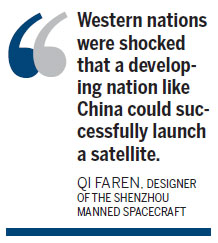The final frontier
Updated: 2012-04-27 08:47
By Xin Dingding (China Daily)
|
|||||||||||

 |
Harnessing space technologies essential for sharpening China's high-tech ambitions
China has made remarkable strides in its space program five centuries after it made the first-ever unsuccessful attempt in the world to put a man in space. History records that some 500 years ago, a Chinese official called Wan Hu tried to launch himself to the moon from a wicker chair to which were fastened 47 rockets. Some records state that there was a huge explosion when the rockets were lit and Wan was never heard of again. Since then nothing much happened on the space front for nearly four centuries in China. Much of this had to do with the general apathy toward rocket technology in China, considering that historical records on the subject were confined to just 25 words. But in the last 50 years, China has not only successfully sent men into space, but also launched lunar probes on its own. On the anvil are plans for a space station, a mission to bring lunar soil samples to Earth, and make available globally by 2020 the Beidou (Compass) satellite navigation, the Chinese version of the US' Global Positioning System (GPS).
satellite navigation, the Chinese version of the US' Global Positioning System (GPS).
The rapid pace at which the space program has grown has also had its downside. Many Western nations have expressed doubts and concerns over the true purpose of China's space program and often attach ulterior motives to it.
|
||||
But experts point out that China has no intentions of dominating the space technologies. Rather, they point out that China is sharpening its technological edge and improving its industries by harnessing space technologies in a peaceful manner for the overall benefit of mankind. The experts further add that most of the technologies that are being used by China are based on technologies already used by nations like Russia and the United States.
In other words, the experts say that while China has no intention of leading the world in space technologies, it would also not like to be left behind.
Early days
In the 1950s, global space programs were largely dominated by the quest for supremacy between the former Soviet Union and the US. Most of the activities centered on putting unmanned satellites in space.
China, at that time, was still a newborn country that was in the throes of transformation and facing several economic hardships. The main priority for policymakers was to feed the masses and as such space programs took a backseat.
Things changed after eminent rocket scientist Qian Xuesen, or Tsien Hsue-shen, who had helped establish the Jet Propulsion Center in California during the 1940s, returned from the US to China for good in the 1950s. In 1956, Qian wrote a letter to the policymakers urging the necessity for China to develop rockets and missiles along with the need for a strong defense industry.
Supported by the top leadership, efforts soon started to develop missiles and rockets, which laid the foundation for launching satellites, according to data from the book The 50 Years of China's Space Industry.
In 1958, buoyed by the satellite launches of the US and the former Soviet Union, the late Chinese leader Mao Zedong expressed the need for China also to launch an artificial Earth satellite.
But that was easier said than done, considering that China did not have the money or the scientific talent at that time. In 1959, the satellite initiative was called off, as it was found not to be in line with the country's strengths.
Scientists, however, were worried that if China completely stopped research on complicated projects such as satellites, it would not be able to catch up with others in the future.
In 1965, Qian submitted a report to the top leadership highlighting the usefulness of satellites in various functions like reconnaissance and communications. Subsequently the satellite program got the green light from the government.
After five years' of work, China launched its first satellite, Dongfanghong-1, into space on April 24, 1970.
Qi Faren, designer of the Shenzhou manned spacecraft who participated in Dongfanghong-1's development, says after the launch, China became the fifth country in the world to independently develop and launch artificial satellites.
"Western nations were shocked that a developing nation like China could successfully launch a satellite. Even more surprising was the fact that at more than 173 kg, the Chinese satellite weighed far more than the combined weight of the satellites launched by other nations," he says.
Since then, China has continued to develop satellites of various types. But it was the technology for recoverable satellites that laid the foundation for manned spaceflights.
Today's Top News
Rescuers race against time for quake victims
Telecom workers restore links
Coal mine blast kills 18 in Jilin
Intl scholarship puts China on the map
More bird flu patients discharged
Gold loses sheen, but still a safe bet
US 'turns blind eye to human rights'
Telecom workers restore links
Hot Topics
Lunar probe , China growth forecasts, Emission rules get tougher, China seen through 'colored lens', International board,
Editor's Picks

|

|

|

|

|

|










